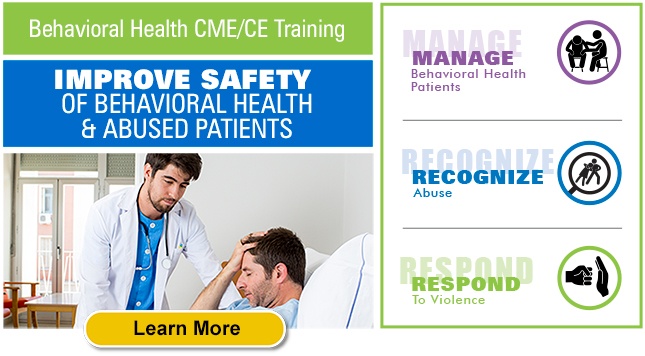
[5 MIN READ]
In recent years, emergency department providers have regularly faced an expanding volume of patients with mental health needs. Then COVID-19 happened, dramatically taxing the healthcare system and increasing demands on providers while also challenging patients’ mental health across the board. In response, it is essential that ED providers increase their knowledge and comfort with the assessment, treatment, and disposition of mental health patients in order to improve timely care for these patients, many of whom require behavioral healthcare in the ED.
EDs Need Tools and Resources for Assessment and Treatment
Psychiatric and substance abuse issues had already more than doubled prior to COVID-19 disrupting our lives more than doubled, rising from 6% to 15% 1. And while traditional visits to the emergency department decreased during the pandemic, visits requiring care for adult psychiatric and substance abuse issues increased substantially. This often presented as anxiety or depression diagnoses, trauma, and stress-related disorders, and increased substance use. Some of these problems manifested as an increase in suicide ideation and attempts.
(It is) more imperative than ever that our EDs have tools and resources to assess and treat these patients.
Further, the number of pediatric patients presenting with mental health issues increased and has remained elevated during the pandemic, with the proportion of children with diagnosed mental health disorders increasing from 24 to 31% last year. As an added pull on the system, inpatient, crisis and other acute psychiatric treatment facilities had to limit their capacity or close due to COVID. This confluence of factors has increased the boarding times for psychiatric patients in EDs. These shifts making it imperative that our EDs have tools and resources to assess and treat these patients.
Mental Illness: Undiagnosed & Untreated
The numbers don’t tell the whole story. Many patients coming into EDs have a mental illness that is undiagnosed and untreated. We did a study2 looking at 100 adults, and the same study with 100 kids, presenting to the ED without a chief complaint of a psychiatric disorder or substance use problem.
We used the Multi-International Neuropsychiatric Interview to screen for any of 16 psychiatric diagnoses. We found that 45% of the adults and 40% of the children (in inner-city Chicago) screened in with one or more psych diagnoses.
With 15% of adult patients presenting with a psychiatric complaint and another 45% having an undiagnosed issue, it’s a top priority for EDs to complete a behavioral assessment.
Best Practices for Working with Behavioral Health Patients in the ED
Emergency physicians and departments often are not comfortable dealing with psychiatric patients. Through education, we can develop a level of comfort with and understanding of the most common behavioral health issues presenting to the ED. We have protocols and entire teams dedicated to specific conditions like chest pain, sepsis, and stroke. We need to do the same for psychiatric patients, making resources available, and educating our providers on the proper steps to work with these patients.
A Protocol for the Agitated Patient
A few years ago, we had 100 patients come into the ED with a psychiatric complaint who self-declared their level of agitation. On a scale of 1 to 5, 80% of those patients felt some level of agitation, even though they may not yet have exhibited the behavior. They weren’t pacing, threatening, or screaming, but inside they were feeling agitated. With this information, we were able to begin a preventive protocol.
- Start assessing a patient’s level of agitation at check-in. Unfortunately, in the ED, we tend to keep a patient with agitation or a psychiatric complaint in the waiting room for minutes to hours before an evaluation. It’s a stressful, noisy, and chaotic environment; it’s inevitable that some might become agitated or out of control. Early assessment allows care to begin before agitation escalates.
- If a patient is agitated, first use verbal de-escalation. Give the patient space and don’t be provocative. Then work to find out the cause or what we can address to help them work through it. You may find the patient only needs a specific problem addressed. Do they just want someone to be with them? Do they need to make a phone call? Do they need something to eat? Are they in pain and just want their medical problem addressed?
- If de-escalation does not work, medicate to calm the patient. The American Association of Psychiatry recommends determining the underlying etiology of the patient’s agitation and then trying to address it with the proper medication. Determine if the agitation is due to substance abuse or an underlying psychiatric illness such as delirium or dementia. You might decide your patient just needs Ativan (lorazepam). If that will not be effective, you may need to administer a Haldol Ativan cocktail.
- Restraint should come as a last resort. If a patient needs to be restrained, we need to ensure that all staff are trained how to do so professionally and appropriately. Well-designed EDs or psychiatric services deal with the front-end issues effectively and rarely resort to restraint.
Trends in Behavioral Health in the ED
 There is a push for EDs to do more to treat psychiatric patients as the health marketplace continues to require providers to do more for less. Providers have to do more to assess patient disposition and determine whether they can go home, be admitted, or (re)start certain medications.
There is a push for EDs to do more to treat psychiatric patients as the health marketplace continues to require providers to do more for less. Providers have to do more to assess patient disposition and determine whether they can go home, be admitted, or (re)start certain medications.
Unfortunately, the resources we have to treat psychiatric patients in some community EDs are limited. More communities and hospitals will move toward acute stabilization units, psychiatric observation or psychiatric emergency service predicated on the reduced dollars and the capability to put these patients into inpatient beds.
Rather than having a patient sit in the ED for hours to days waiting for an inpatient bed, we could place them in psychiatric observation. Studies—as well as my personal experience—have demonstrated that many patients can go home after approximately 24 hours of treatment. I think we’ll see more emphasis on EDs finding reasonable and appropriate treatment locations for psychiatric patients instead of pushing them into inpatient beds, and resources will be more limited for psychiatric inpatient services as time goes on.
We are starting to see a shift toward the model of integrated care. As part of the Lake County Health Department, we have now embedded a behavioral health specialty into each of our six federally qualified health centers. In places like this, patients can see a primary care provider with a counselor right next door. Evaluation is prompt, and if treatment is necessary, referrals can be made to a psychiatric service or substance abuse treatment. This integrated model has the potential to treat patients before their complaints warrant hospitalization or a visit to the emergency department.
Resources:
- Morbidity and Mortality Weekly Report Weekly / Vol. 69 / No. 32 August 14, 2020; “Morbidity and Mortality Weekly Report Weekly / Vol. 69 / No. 32 August 14, 2020” Mark É. Czeisler1,2; Rashon I. Lane MA3; Emiko Petrosky, MD3; Joshua F. Wiley, PhD1; Aleta Christensen, MPH3; Rashid Njai, PhD3; Matthew D. Weaver, PhD1,4,5; Rebecca Robbins, PhD4,5; Elise R. Facer-Childs, PhD1; Laura K. Barger, PhD4,5
- The Journal of Emergency Medicine|BRIEF REPORTS| VOLUME 43, ISSUE 5, P876-882, NOVEMBER 01, 2012; “Undiagnosed Mental Illness in the Emergency Department;” La Vonne A. Downey, PhD; Leslie S. Zun, MD, MBA; Trena Burke, MPA


